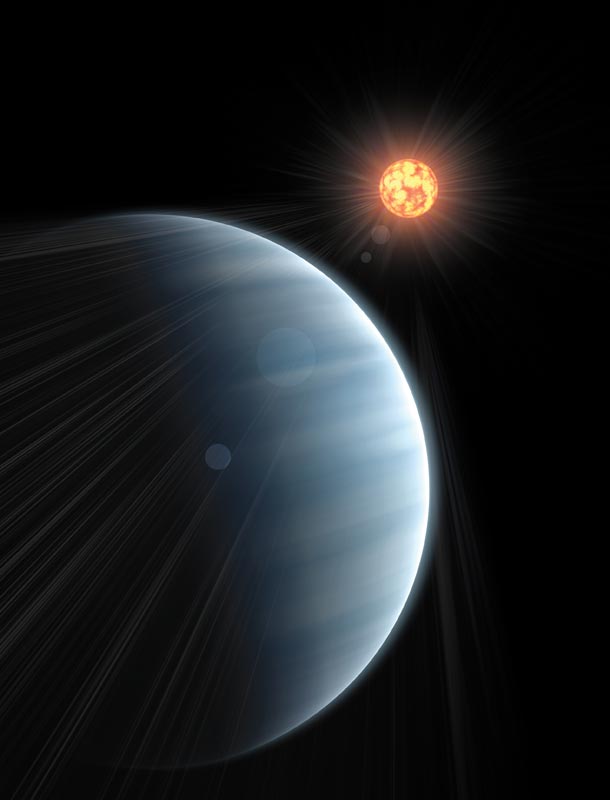
A team of astronomers has made the first direct measurement of the atmosphere of an exoplanetary “super-Earth”. The findings suggest that the exoplanet named GJ 1214b has either an atmosphere swarming with clouds or one enveloped in water vapour.
Since the discovery of the first extra-solar planet – or exoplanet – in 1995, over 500 more have subsequently been unveiled. While most of these are gas giants like Jupiter, astronomers are getting better at finding smaller exoplanets that could be more similar to Earth.
GJ 1214b weighs in at 6.5 Earth masses and is a so called super-Earth because it tips the scales at between twice and ten times the mass of our own planet. Discovered in 2009, and circling a star approximately 40 light-years from Earth, the exoplanet’s low density implied that it is blanketed by an atmosphere. However, until this latest research, led by Jacob Bean at the Harvard-Smithsonian Center for Astrophysics, US, direct measurements of this atmosphere had remained elusive.
Bean and colleagues used a spectrograph, attached to the Very Large Telescope (VLT), to analyse light from the parent star as the planet passed in front of it. During such a transit some starlight passes through the planet’s atmosphere and can be soaked up by its constituent chemicals. This produces a spectrum containing tell-tale fingerprints – gaps at wavelengths where light is absorbed by the atmosphere. Crucially, Bean’s spectrum for GJ 1214b was featureless: there were no gaps in the data.
Cloud-free skies ruled out
Such a result rules out models suggesting the possibility of a cloud-free, hydrogen-rich atmosphere similar in composition to Neptune. Hydrogen, the lightest element, doesn’t cling very tightly to a planet, giving it a better chance of absorbing incoming sunlight. “A hydrogen-dominated atmosphere would be very ‘puffy’,” Bean told physicsworld.com. “It is this puffiness that would have given a very strong signature in the spectrum that we measured,” he added.
The lack of such a signature leaves two rival explanations fighting to explain Bean’s finding. “The featureless spectrum tells us that it is probably a very dense atmosphere. However, the alternative is that it does have a puffy atmosphere but with thick, high clouds that we can’t see through, similar to Venus, or [Saturn’s largest Moon] Titan,” explained Bean.
I think we’ll get the answer within a year, maybe even sooner Jacob Bean, Harvard-Smithsonian Center for Astrophysics
Should it turn out to be the former, the most likely chemical candidate is water vapour; GJ 1214b orbits so close to its host star that it could well be shrouded in steam. Bean is confident of nailing the answer soon: “I think we’ll get the answer within a year, maybe even sooner, we just need longer wavelength observations. Whilst clouds and hazes give a uniform absorption over the wavelength range we used, over very large wavelengths you would expect a difference,” he said.
However, some researchers are cautious. “They’ve done this looking through the Earth’s atmosphere, which is never a friend to astronomy,” Carole Haswell, an exoplanet researcher at the Open University, told physicsworld.com. “What they’ve done is very difficult; any slight systematic effects are going to have a huge effect on the conclusions that you draw. It’s good, solid and exciting stuff but I’d like to see it checked from space, e.g. with Hubble,” she added.
Should Bean’s findings be confirmed, Haswell sees this area of research as a crucial part of finding a “second Earth”. “If you can measure the composition of the atmospheres of planets like GJ 1214b then you are getting quite close to saying how similar they are to Earth. This is a big step in addressing the question of whether Earth is unique,” she explained.
This is a pretty major stepping stone in getting to the end goal of finding an Earth-like planet with signatures of life David Sing, University of Exeter
David Sing, who researches exoplanet atmospheres at the University of Exeter, agrees. “There have been a number of spectral studies of so-called ‘hot-Jupiters’ but this is the first time it’s been done for a terrestrial-type planet,” he said. “This is a pretty major stepping stone in getting to the end goal of finding an Earth-like planet with signatures of life,” he added.
And Haswell believes we’ve come along way in a short period of time, telling physicsworld.com: “The fact that in 1995 we didn’t know of any planets around other stars and now we’re measuring the atmospheres of planets in the same ball park as the Earth is amazing.”
The findings are described in a paper published in Nature 468 669.



